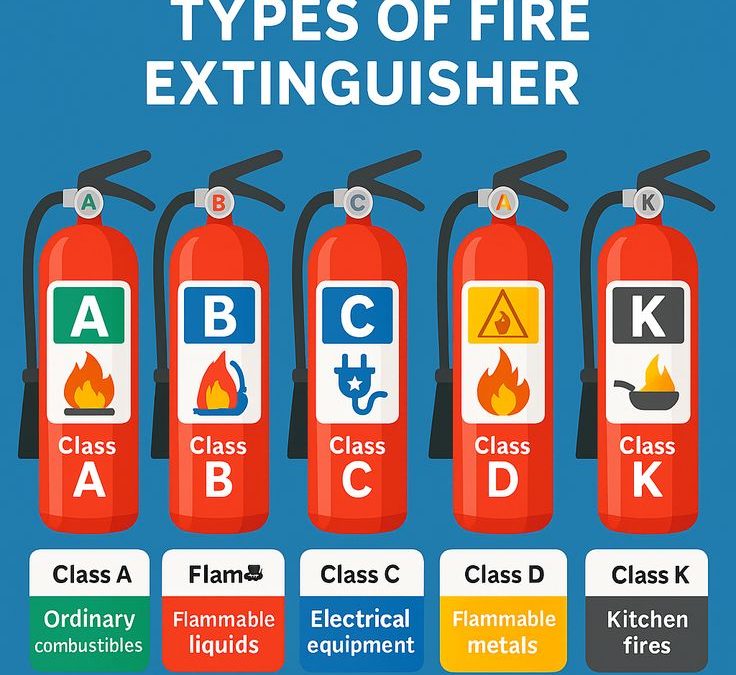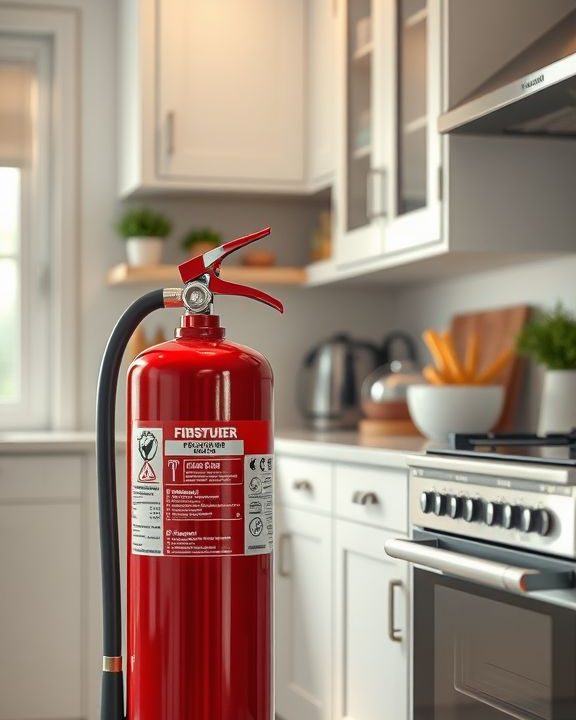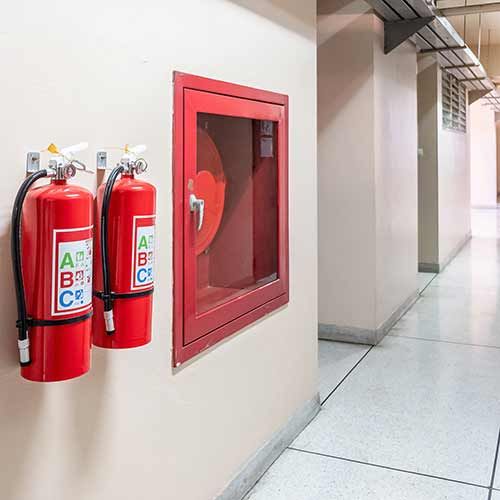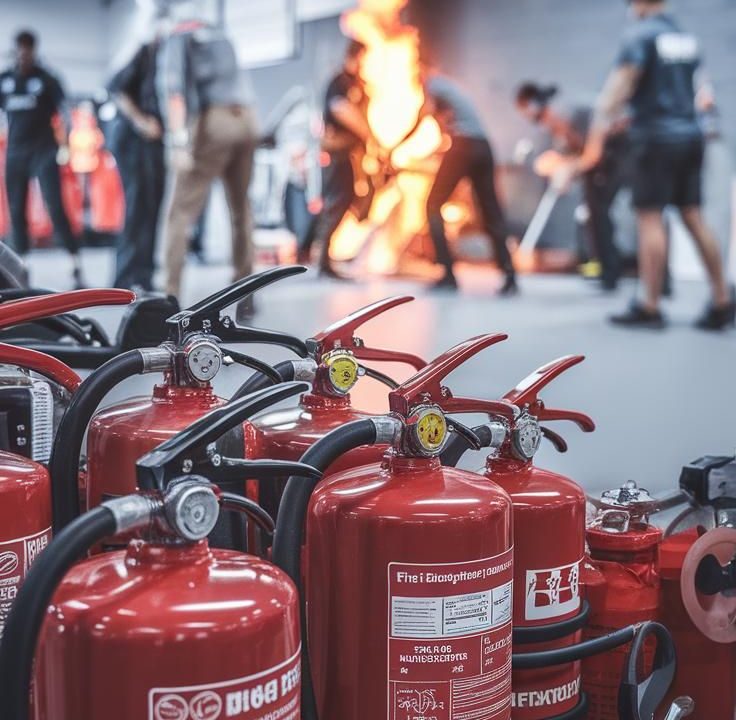Understanding Different Types of Fire Extinguishers & Their Uses

How Often Do You Need to Replace Your Fire Extinguisher?
October 1, 2025
How Often Should You Inspect Your Fire Extinguisher? Key Maintenance Tips
October 31, 2025You find yourself in a hardware store in front of a wall of fire extinguishers, with different letters, numbers, and colors on them, and you do not know which one you really need. The salesperson tosses around words such as Class A, ABC rated, dry powder, but all you really need to know is how one of these will actually calm a fire in your kitchen.
The improper type of fire extinguishers may, in fact, contribute to a fire. Putting water on an electrical fire exposes one to the danger of electrocution. It could be life-threatening.
If you’re looking for quality firefighting equipment, suppliers like Safety First do provide a complete range of equipment to deal with common fire hazards.
Key Takeaways:
- Classes (A, B, C, D, K) are associated with certain types of fires, and the incorrect choice can just worsen the condition.
- ABC extinguishers deal with the majority of domestic firefights, although they are not necessarily suitable for kitchens or electrical devices.
- The optimal home extinguisher is based on what risks you are prone to, and your locality will need various protection measures.
- Appropriate training and knowledge of the PASS technique are as essential as the correct equipment.
Different Fire Extinguisher Classes:
These classes are based on the fire type:
- Class A:
Common fires include wood, paper, cloth, and some plastics. These fires leave ash and burn with visible flames.
- Class B:
Flammable liquid, including gasoline, oil, paint, and grease. These fires don’t leave ash and can spread rapidly.
- Class C:
Live electrical equipment, including panels, motors, and wiring. Once you cut the power, it becomes a Class A fire.
- Class D:
Combustible metals like magnesium, aluminum, and lithium. Critical in industrial settings.
- Class K:
Cooking oils and fats in commercial kitchens. These fires require special agents.
ABC Fire Extinguishers: The Multi-Purpose Solution
These extinguishers are combination gadgets capable of dealing with Class A, Class B, and Class C fires and are thus common in kitchen and garage settings where more than one type of fire may occur.
Best Fire Extinguisher for Home Use
The majority of fire safety professionals suggest beginning with an all-purpose ABC unit in a general setting, but adapting your strategy to risk-specific room hazards.
- Kitchen Areas:
ABC units are functional; Class K extinguishers are specifically used on cooking fires and will not propagate burning oil. In the case of most home kitchens, a smaller Class K unit with a fire blanket is more protective than relying on ABC alone.
- Electrical Areas:
CO2 extinguishers have no residue and cannot destroy delicate electronics, thus are suitable around computer systems, electrical systems, or home offices.
- General Living Areas:
ABC units are widely used to offer wide coverage to the mixed combustible substances that are present in the majority of homes.
Fire Extinguisher Sizes and Placement Strategy
Sizes are rated by weight and the area they cover. Common residential sizes include 2.5, 5, and 10-pound units. You need to be able to lift and operate the extinguisher effectively during an emergency.
- 2.5-pound units:
Easy to handle, good for vehicles or small spaces, but limited capacity.
- 5-pound units:
Best balance for most homes – manageable weight with adequate firefighting capacity.
- 10-pound units:
More firefighting power but heavier to maneuver. Good for garages or workshops.
Fire Extinguisher for Electrical Fires
Carbon dioxide ( CO2 ) extinguishers are engineered to address fire in Class B and C electrical and fuel-associated situations. They operate by displacing oxygen and provide no residual, therefore they are superior to use in electrical equipment.
Do not try to extinguish electrical fires with water, as it poses an electrocution hazard.
Steps of Using a Fire Extinguisher
The PASS method gives a basic outline:
- PULL: It takes out the safety pin and holds the extinguisher in an upright position.
- AIM: Squeeze the nozzle or hose at the bottom of the flames, and not the top.
- SQUEEZE: Push the lever to discharge the extinguishing agent.
- SWEEP: Slide the spray sideways, across the fire base until the fire is extinguished.
Fire Extinguisher Equipment and Training
You need the right equipment and training to be able to use it in an emergency. During crises, a great number of individuals become paralyzed or commit fatal errors that decrease efficiency.
Planning annual training sessions and periodical equipment inspection can help keep skills and equipment prepared.
Fire Extinguisher Uses by Location
Different areas require different uses and strategies:
- Kitchens: Class K for cooking fires, supplemented with fire blankets for small grease fires.
- Garages: ABC units for mixed combustible materials, tools, and automotive fluids.
- Basements: ABC units for general protection, CO2 for electrical panels or equipment.
- Offices: CO2 for electronics, ABC for general materials.
Understanding these specific applications helps you create comprehensive protection rather than relying on one-size-fits-all solutions.
Conclusion
It is not only about mandatory rules, but about the safety of your family, property, and livelihood when using the appropriate equipment. It is all about categorizing extinguishers to your respective fire hazards, and also, everyone must learn how to use them.
Make sure you know the fire hazards, select the right equipment, and obtain quality training.
Frequently Asked Questions
1: What are the main types of fire extinguishers and their uses?
It consists of 5 key classes: A (ordinary combustibles), B (flammable liquids), C (electrical equipment), D (combustible metals), and K (cooking oils). All types have agents that are specific to a fire hazard..
2: Can I use a water fire extinguisher on an electrical fire?
Do not use water on an electrical fire. Water is electrically conductive and is dangerous because of electrocution. Rather, apply CO2 or dry chemical extinction units of Class C fire.
3: What is the difference between Class A, B, C, D, and K extinguishers?
Class A: wooden, paper, Class B: flammable liquids, Class C: electrical equipment, Class D: metals, Class K: cooking oils.
4: What is the safest fire extinguisher for kitchen use?
Class K extinguishers refer to cooking fire extinguishers. Class K units and fire blankets have more protection compared to the general ABC units in the case of home kitchens.
5: How to operate fire extinguishers effectively?
All extinguishers work based on the PASS technique. There should always be an escape route and never back up to extinct fires.




